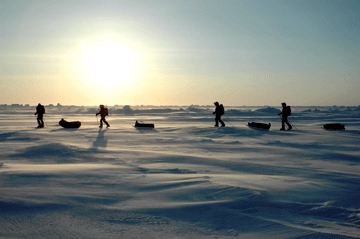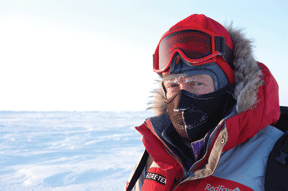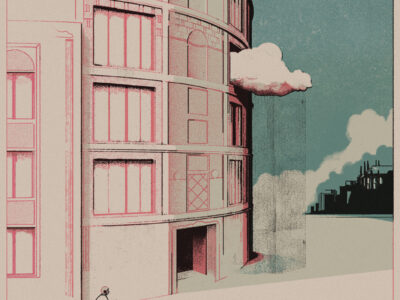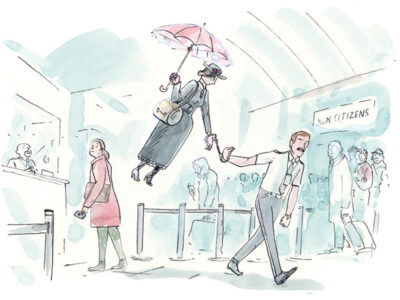
Getting to the North Pole the hard way.
By Alexei Dmitriev
“Are these my absolutely warmest socks?” I asked Suzette.
“You can take two pairs. My God, you are packing as if you were going to the North Pole,” she said, and then laughed. That was precisely where I was heading.
A month before, over a chat in a St. Petersburg café, Victor Boyarsky had invited me to join him on a “last degree” trip. It meant skiing from the 89th parallel to the North Pole—a distance of about 60 miles depending on how the ice drifts.

Victor, the director of St. Petersburg’s Arctic and Antarctic Museum, looked unmistakably like a polar explorer. He stroked an unruly beard that he must have grown while crossing Greenland on a dog sled or some other exploit, and studied me through squinted eyes as if trying to figure out whether I’d make it to the Pole on my own or need to be carried.
“I jog in the morning,” I offered. “Should I switch to weight training? Or work on my will power?” I wanted to dispel his doubts.
“Everything will be fine,” he said with a smile as we stepped outside into a remarkably balmy January. “Your timing is good. A few more winters like this one and the only way to get to the Pole will be by boat—or by swimming.”
Despite his assurances, I decided to stay prepared. I gained a few pounds of subcutaneous fat against the possibility of getting stuck on ice without food. I bought a plastic urinal bottle so as not to venture out of the tent at night. Finally, I called the Polarka vodka company in Rostov, Russia, and suggested they sponsor my trip in exchange for testing and photographing their product in situ. They declined.
Then I got on the Internet to see what other polar travelers had to say about their experiences. They were surprisingly mellow about the difficulties. Especially the ones who reached the Pole aboard an atomic icebreaker. “We gathered on the bridge and when the ship signaled the arrival at the Pole, the champagne started to flow and we all congratulated each other. In half an hour the barbecue grills were set up on the ice below and tasty kebabs were served. Then we formed a circle and danced around the pole with flags of all countries whose citizens had joined our arctic cruise.”
For a moment I felt bad for all the intrepid explorers who had faced immense hardships trying to get to this place. I lamented Robert Peary’s amputated toes. All those sacrifices just so another lazy tourist could put in his blog: “We arrived to the top of the world. The blue and white landscape stretched in every direction. It was hard to imagine that this was the place so many people gave their lives for.” Sure—hard to imagine in the comfort of an upper-deck cabin! Now it was my turn to see whether the Pole could still throw up a good challenge in the era of Gore-Tex, fleece, and Iridium phones.
In early April I flew to the northernmost airport served by commercial carriers: Longyearbyen, in Norway’s Svalbard archipelago.
Svalbard boasts more polar bears than humans, and has the feel of a frontier since the latter are obliged to carry guns outside of town to fend off the former. Victor took me to a warehouse to procure gear for the trip—enough clothes and accessories to outfit two or three people for a winter hike in Vermont. I was also given a sled that looked like a canoe, already filled with a tent, a petrol stove, sleeping bag, food, and cooking utensils.
I was told to pack wisely, as I would be pulling the sled myself. But what did I need if dancing around flagpoles while drinking champagne was not on my agenda?
Others in the warehouse seemed to know exactly what to take. Georges Baumann from Switzerland had sold his house to finance a solo trip to the Pole. There was a team of Indian naval officers that had already conquered the South Pole and Mount Everest. All of us boarded the flight to Arctic base Barneo later that day.
Every year in late March, Victor’s company and another build Barneo from scratch. A dozen people and a tractor are dropped from the sky to make a landing strip on an ice floe about 50 miles from the Pole. Once that’s ready, two AN-74 transport planes shuttle back and forth from Longyearbyen with the fuel and supplies that will make life a bit more comfortable for the staff, researchers, and about 250 tourists who will pass through in the next month, before the weather deteriorates and everything is removed. Three helicopters are kept on standby; there is no one else within 500 miles capable of emergency airlifts.
As I stepped off the plane, icy wind shoved my breath back into my mouth. For the next five days I remained overwhelmed. The Arctic makes one see new facets of familiar objects, which suddenly require so much more attention that they seem alien. The cold keeps you on your toes without pause. Staying warm becomes an obsession. A mitten lost to the wind at 30 below zero is a dangerous mistake. Forget to stow your toothpaste in your sleeping bag in the evening, and it will be stone-hard in the morning. Bring your camera into the warm tent, and it gets covered with condensation; take it outside again, and the moisture freezes to crack the LCD display.
Losing your sleeping bag is cause for evacuation: I remember how madly I sprinted after mine when the wind had wrestled it away and sent it flying towards Murmansk so fast it seemed it would get there in a matter of hours.
In the mess tent, hot air was pumped in by diesel compressors. Gala Paramonova, a Barneo veteran and our guardian angel, would bring hot tea and sandwiches. “I’ve seen them all,” she told us. “The prince of Monaco, the prime ministers, the archbishops. Lots of crazies come here, too—some on a honeymoon, some in wheelchairs, some to run a marathon or do whatever will get them in the record books. Some monster parents last year brought a one-year-old!”
But Barneo is only an intermezzo. As the orange belly of the helicopter that just dropped you off gets smaller and smaller overhead, you realize that now you are finally facing the great white silence. You are not alone in this icy desert, but so far away from what you are used to that your heart sinks.
There are few distractions on the way to the Pole, but the experience is far from boring. You walk (polar skis, bearing strips of fake reindeer hide on the bottom to prevent backsliding, do not glide very well) and listen to your breathing and the crackling of snow underfoot. Just as you get yourself warm and into a nice rhythm, you inevitably encounter a pressure ridge that looks like a fortress wall. You take your skis off, climb on top of the six-foot-thick blocks of blue ice, pull the sled up behind you, and then try to descend without getting hit in the back of your head.
If you come across open water, you try to walk around it or set up camp and wait for the water to freeze. It usually takes about six hours for ice capable of supporting your weight to form. There are no polar bears, walruses, birds, or fish. Other than the plankton, the nearest life is aboard the U.S. and Russian submarines playing hide-and-seek in two and a half miles of black water below.
You make your own time near the Pole; the sun goes around the horizon. You take a break when you get tired and you make camp when you’ve been walking for eight hours or so. It is not easy to screw the anchors into ice, but no matter how tired you are, a sloppy job will cost you: a little wind will flap the canvas and keep you awake, a lot will blow the tent away completely—with you, your mate, and all your gear inside.
You have to drink a gallon of tea or chicken broth every day, for the air in the Arctic is as dry as the air above the Sahara. And you have to eat a ton: nuts, chocolate, sublimated beef, dry soups, powdered cheese … 5,000 calories a day, most of which are consumed to stay warm.
Five minutes after the stove is shut off, the temperature inside and outside the tent are the same. Then you seek refuge in the sleeping bag—along with the satellite phone batteries and anything else you don’t want to go dead frozen on you. Close the hood too tight, and you start to suffocate. Too loose, and your eyeballs start to ache from cold.
Midway through the night, a fresh bottle of warm urine can be deployed to keep the feet warm, but even there it turns to ice by the time you get up. Our morning conversation revolved around how to get rid of the yellow ice in the bottle. New additions did not melt old ones, and became dead weight in the sled. My urine made it back to Longyearbyen, where we were parted only because of the Radisson hotel’s warmth.
Victor had all these issues under control. His urine stayed liquid (high alcohol content?), and all his zippers had little cords attached so that he could open and close them with his mittens on. Everything in his tent knew its place, so he had twice as much room. He was friends with the Arctic. He would even take a snow bath every day.
Meanwhile, others would whine, “Listen, the air is ringing!” I do not know whether it was the ice, or the air, or our mass hallucinations, but the Arctic seemed to hum like a mouth harp all around us.
On the fifth day, we walked as usual, cursing the southern drift that had been robbing us of a couple miles by day and even more by night. Then Victor started zigzagging like a hare being chased. After 10 minutes of this he looked again at his GPS unit and stopped.
“Congratulations! We have reached the geographic North Pole!” He took out his flare gun and saluted the achievement. We looked at each other, relieved and incredulous at the same time. The same southerly wind (all winds are southerly at the North Pole) was working hard to frostbite whatever skin patches we had exposed. We were surrounded by the same ice ridges and snow. And no striped earth axis protruded from the ice to hang our backpacks on.
The North Pole is the biggest non-attraction in the world. It exists in all time zones simultaneously. It makes the compass useless. It is completely intangible, because only cartographers know its position on the ocean floor. On this day, it would not allow us to savor our triumph, because while we were shedding our skis and getting our cameras to work, the ice below us drifted 500 feet. I was never able to see the 90’00”00”’N coordinates on the GPS display.
But more powerfully than anywhere I had been before, the Pole gave me that sensation which lies at the heart of all travel: that the road is everything and the destination nothing. What escaped those champagne swillers aboard the atomic icebreaker (we could only toast with vodka; everything else would freeze!) was that the harder and longer the path, the more precious the experience becomes. There is a reason people are in awe of the Arctic. It gives them access to a basic, almost animal existence in the age of space travel. That’s why they’re willing to plunk down over $20,000 for a trip like this.
Well, that plus the convenience of being able to call in a chopper so no one has to walk back to the mainland.
Alexei Dmitriev G’88 is a documentary filmmaker who lives in Potomac, Maryland.




